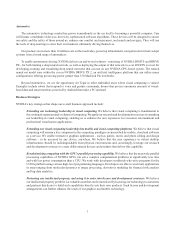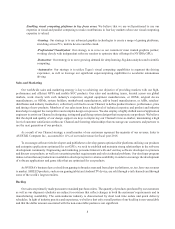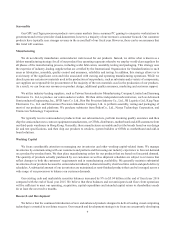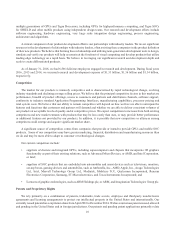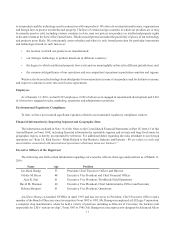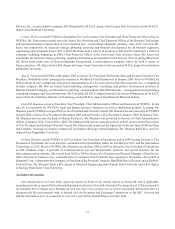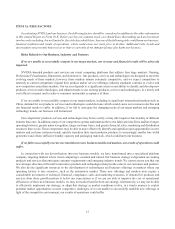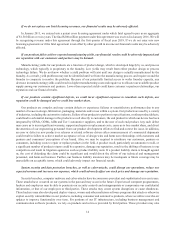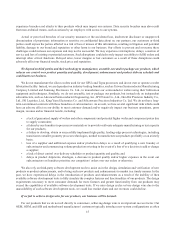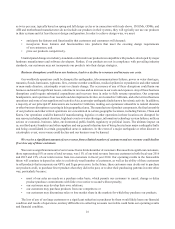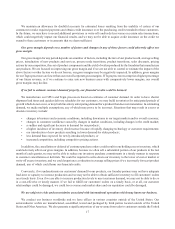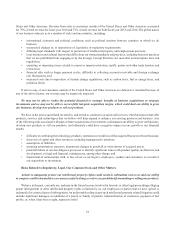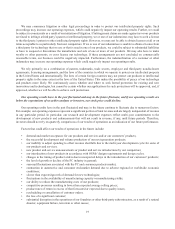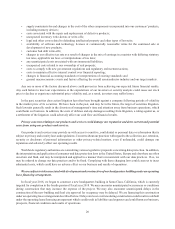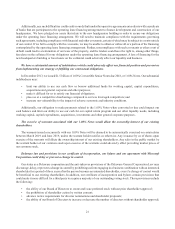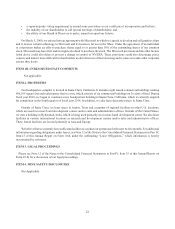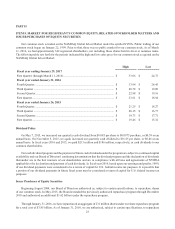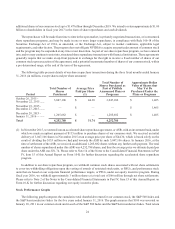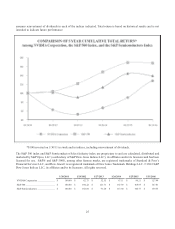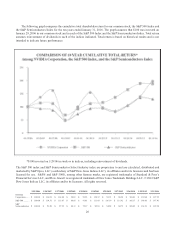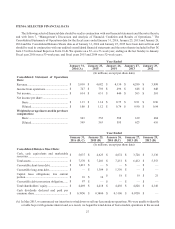NVIDIA 2016 Annual Report Download - page 163
Download and view the complete annual report
Please find page 163 of the 2016 NVIDIA annual report below. You can navigate through the pages in the report by either clicking on the pages listed below, or by using the keyword search tool below to find specific information within the annual report.17
We maintain an allowance for doubtful accounts for estimated losses resulting from the inability of certain of our
customers to make required payments and obtain credit insurance over the purchasing credit extended to these customers.
In the future, we may have to record additional provisions or write-offs and/or defer revenue on certain sales transactions,
which could negatively impact our financial results, and we may not be able to acquire credit insurance on the credit we
extend to these customers or in amounts that we deem sufficient.
Our gross margin depends on a number of factors and changes in any of these factors could adversely affect our
gross margin.
Our gross margin for any period depends on a number of factors, including the mix of our products sold, average selling
prices, introduction of new products and services, process node transitions, product transitions, sales discounts, pricing
actions by our competitors, the cost of product components and the yield of wafers produced by the foundries that manufacture
our products. We are focused on improving our gross margin and if we are not able to control or estimate the impact of the
above factors or other factors we do not foresee, our gross margins may be negatively impacted. In addition, gross margins
for our Tegra processors are lower than our overall corporate gross margins. If Tegra processors comprise a higher percentage
of our future revenue, or if we continue to enter into new business areas with comparatively lower margins, our overall
gross margins may decline.
If we fail to estimate customer demand properly, our financial results could be harmed.
We manufacture our GPUs and Tegra processors based on estimates of customer demand. In order to have shorter
shipment lead times and quicker delivery schedules for our customers, we may build inventories for anticipated periods of
growth which do not occur, or may build inventory anticipating demand for a product that does not materialize. In estimating
demand, we make multiple assumptions, any of which may prove to be incorrect. Situations that may result in excess or
obsolete inventory include:
• changes in business and economic conditions, including downturns in our target markets and/or overall economy;
• changes in consumer confidence caused by changes in market conditions, including changes in the credit market;
• a sudden and significant decrease in demand for our products;
• a higher incidence of inventory obsolescence because of rapidly changing technology or customer requirements;
• our introduction of new products resulting in lower demand for older products;
• less demand than expected for newly-introduced products; or
• increased competition, including competitive pricing actions.
In addition, the cancellation or deferral of customer purchase orders could result in our holding excess inventory, which
could adversely affect our gross margins. In addition, because we often sell a substantial portion of our products in the last
month of each quarter, we may not be able to reduce our inventory purchase commitments in a timely manner in response
to customer cancellations or deferrals. We could be required to write-down our inventory to the lower of cost or market or
write-off excess inventory, and we could experience a reduction in average selling prices if we incorrectly forecast product
demand, any of which could harm our financial results.
Conversely, if we underestimate our customers' demand for our products, our foundry partners may not have adequate
lead-time or capacity to increase production and we may not be able to obtain sufficient inventory to fill customers' orders
on a timely basis. Even if we are able to increase production levels to meet customer demand, we may not be able to do so
in a cost-effective or timely manner. If we fail to fulfill our customers' orders on a timely basis, or at all, our customer
relationships could be damaged, we could lose revenue and market share and our reputation could be damaged.
We are subject to risks and uncertainties associated with international operations which may harm our business.
We conduct our business worldwide and we have offices in various countries outside of the United States. Our
semiconductor wafers are manufactured, assembled, tested and packaged by third parties located outside of the United
States and Other Americas. We also generate a significant portion of our revenue from sales to customers outside the United


